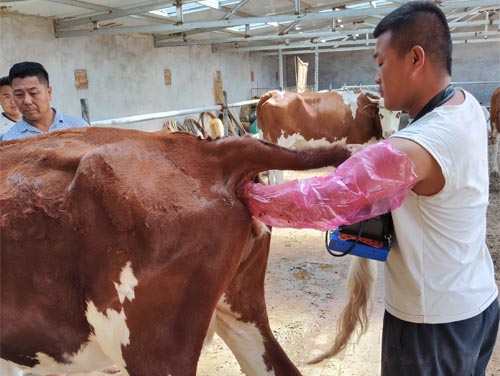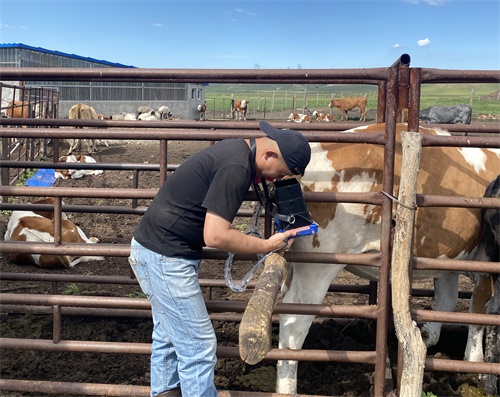Hey there! Let’s talk about something super important on the farm—pregnancy checking our cows. It’s a total game-changer for keeping everything running smooth. I want to share how I and some fellow livestock farmers—especially friends abroad—approach this. Picture us leaning on the fence on a sunny afternoon, swapping stories about cattle, pregnancy detection, what works, what doesn’t. Hope it feels like that, not stiff or robotic.

Why pregnancy checking matters to us outside every stall
When you don’t know which cow’s pregnant, what stage she’s in, or if she’s not pregnant at all—you end up feeding and managing blind. In many ranches I’ve talked to across the US, Australia, even parts of Europe, folks rely on pregnancy checking to make decisions: who gets kept, who gets bred again, how to plan feed rations, when to separate heifers. It’s not just clinical—it’s practical.
A friend in New Zealand told me he schedules scans right after breeding season. He jots down who bred when, then uses ultrasound or palpation later to sort things out. Another contact in Canada does pregnancy testing around 45 days after AI. Why? Because early detection helps avoid wasting feed on cows that need rebred. Makes sense, huh?
Techniques farmers use in their daily routine
Couple of main methods show up again and again in conversations:
Palpation (rectal) – old-school, but still widely used. Ranch hands or vets feel the reproductive tract, search for a membrane slip or feel a calf. Fast, cheap, but needs experience and gentle hands.
Ultrasound (trans-rectal) – using an ultrasound probe. Provides visuals: heartbeat, fetus, everything. Some producers love this for early detection around 30-35 days post-breeding. You can even detect twins. A buddy in Texas swears by it during cold mornings—he sets up a cozy barn stall, warms up the probe (hey, even equipment likes comfort), and checks quickly.
Blood tests / milk tests – detecting pregnancy-associated proteins. They're less common on small-scale farms but growing fast in Europe. You collect blood or milk, send it off, get results in a day or two. Convenient when you don’t want long handling sessions.
Sometimes we mix these. My neighbor uses palpation first, then ultrasound on unsure ones. Another ranch uses palpation first, then confirms with a blood test for any ambiguous results. That extra confidence helps make decisions faster.

What foreign ranchers say about timing and accuracy
People overseas often emphasize when to check. Too early, and you risk false negatives. Too late, and you might have missed opportunities to intervene or re-breed. Here’s a rough friend-to-friend breakdown I gathered:
| Time after breeding | Method of choice | Why it’s handy |
|---|---|---|
| ~30–35 days | Ultrasound | See heartbeat, early detect |
| ~40–60 days | Palpation (rectal) | Reliable, trained hands |
| ~60+ days | Blood/milk test | Easy, minimal handling stress |
| ~90+ days | Any method, but high accuracy | Confirm and update records |
So many ranchers I’ve chatted with note that using ultrasound early saves feed costs and helps plan for calving. For cows that didn’t hold, you can re-breed quickly instead of waiting. And everyone agrees: patience + timing = better outcomes.
Stories and practical tips that helped me
A rancher in the UK told me she once palped too early—around day 25. Her vet felt something, but she lost pregnancy the next week. That led her to wait until day 35 or 40. Sensitive timing matters.
A friend in Argentina invested in a portable ultrasound machine. He said it paid off quickly: saved feed for non-pregnant cows and let him plan groupings by calving date. Plus, being able to show real images to trainees is powerful—makes teaching easy.
In Germany, one colleague said, when using blood tests, she schedules them around day 60. She groups cows by expected calving dates and pulls samples while doing routine vaccinations. Efficient and low-stress.
Mixing methods helps too. For example, those uncertain by palpation get checked again with ultrasound. Or if you spotted twins early, you plan for management differently. One Brazilian farmer said, “If I see twins early, I isolate them, manage feed separately, and watch for calving complications.” Totally practical and caring.

Managing results—what to do when you know who’s pregnant
Once pregnancy status is known, action steps flow much smoother:
Pregnant cows – separate them by calving window, adjust feed to support pregnancy needs, reduce stress, vaccinate on schedule.
Not pregnant – re-breed as soon as possible, or determine if there's health or fertility issues. You save feed by not over-feeding empty cows.
Twins or complications – those cows go into special monitoring group, maybe extra feed, closer calving observations.
I mark everything in a notebook or digital app as soon as I get results. Then I talk to my team—everyone knows which group goes where. Clear info keeps everyone coordinated.
Balancing cost, labor, and stress on the farm
Hands-down, the best approach fits your operation size and staffing:
If you’re solo or small scale, palpation with vet help may be best—cheap and fast.
If you have help or want to train juniors, ultrasound offers visual learning and early results.
If stress is a worry—like handling older cows or tight facilities—blood/milk tests help you avoid extra standing and handling.
One US operator I know scans half his herd in under an hour early morning, during milking. No long waits. Another in Spain says they mail off bulk milk tank samples from each group—pregnancy status comes back electronically. Minimal extra hands needed.
Wrapping up thoughts
Pregnancy checking cattle helps farms run smarter. You know who’s pregnant, you sort them, you feed smart, and you plan calving better. That leads to healthier animals, lower costs, and less wasted effort.
Hope this felt like a casual chat rather than a lecture. Imagine we’re on the farm porch, sipping coffee, chatting about what worked last season and what might work next. Drop me a note if you’d like to dive deeper into any method—I'm always happy to share more stories or details.
tags: Pregnancy Check Cattle


